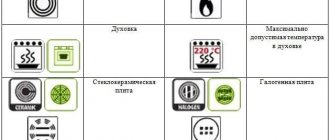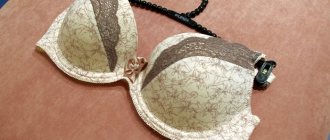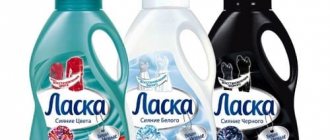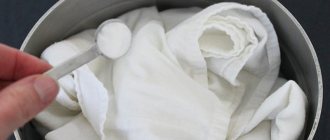Washing machine installation
Before you start washing, it is better to make sure that the machine is installed correctly and will not vibrate or move during operation. The unit must be placed only on a hard floor, leveled and the legs firmly secured with locknuts. If you place the device on a smooth tile, then place a thick rubber mat under it to avoid moving.
It is logical to store dirty laundry in the bathroom in a wicker basket or drawer with small holes.
Preparation
Immediately before loading the machine, all items must be prepared for washing. The first thing you need to do is check your pockets - it will be very disappointing to wash money, travel tickets, flash drives, business cards or other necessary items.
On clothes you need to fasten all the zippers and buttons, tie the laces, but it is better to leave the buttons undone. It is better to straighten the sleeves of shirts, and turn trousers and jeans inside out. Pins and other iron objects, belts and belts, as well as loose buttons should be removed from clothing.
It is recommended to turn pillowcases and duvet covers inside out and shake out any fuzz from their corners. You should also turn stockings, socks, and clothing made from knitwear or terry cloth inside out. Small items and underwear are best placed in a special laundry bag.
Of course, it is better not to leave stains on clothes for a long time, but if they “survived” before washing, treat them with special products.
Important Rules
Modern devices make the washing process as simple as possible. All you have to do is put down your laundry and select a program. However, despite the ease of use, problems sometimes arise.
To get clean laundry you need to know simple rules.
- It is necessary to distribute the laundry according to material, color and degree of soiling.
- Check for foreign objects in pockets. They must be empty.
- Remove metal objects from items, and close pockets and zippers.
- Knitted clothing should be placed inside out in the drum.
- Bedding should not be folded inside each other.
Thanks to the manipulations listed above, you can get not only well-washed items, but also maintain their quality.
Putting clothes in the car
When placing clothes in the washing machine, you must adhere to the manufacturer’s recommendations and observe the optimal load weight specified in the instructions. Do not fill the machine to capacity; distribute the items evenly for each wash. Avoid washing items that are too large and too small (such as sheets and socks) together to avoid causing the machine to become unbalanced.
Avoid washing items that are too large and too small (such as sheets and socks) together to avoid causing the machine to become unbalanced.
It is not necessary to weigh the laundry before each wash - just remember that a full load for cotton laundry is a completely filled, unpacked drum, for synthetics - a half-filled drum, and when washing wool - a drum one-third full.
How to take care of your device
Any equipment tends to break down. Most often this happens not due to manufacturing defects or wear of parts, but due to improper operation.
To increase the life of the device, you should follow the recommendations for its use specified in the passport, and also follow certain rules:
- Each model has its own loading. Do not overload it in order to save time, water or electricity.
- For each type of fabric you need to choose your own mode.
- The powder must be poured into special sections (with the exception of liquid products).
- The amount of powder is taken in the dosages specified by the manufacturer.
When choosing equipment, many buyers look at the number of functions, but in fact use only a third of them. Don't overpay for extra features.
You might also be interested in:
What to do if the washing machine does not fill the drum with water - Causes of failure
Program selection
When choosing the appropriate program and temperature for washing and spinning, you can be guided by the signs that are given on the labels sewn on the clothes.
But if such shortcuts are not preserved, you can follow the general recommendations:
- Durable light-colored cotton and linen fabrics can be washed at 95 degrees and spin at the highest possible speed.
- Colored cotton linen can be washed in hot water up to 60 degrees, and they are not afraid of spinning at the highest speeds.
- It is recommended to wash items made from synthetic fabrics at a temperature no higher than 50 degrees and spin at a speed of 800-900 rpm.
- To wash items made of delicate fabrics (for example, wool or silk), it is permissible to heat the water no higher than 40 degrees, and spin at low speeds - no more than 600 per minute.
- Items that may fade are best washed in cool water no higher than 30 degrees.
Popular Features
Of course, each manufacturer tries to introduce its own characteristics into the washing process and develops new technologies. Despite this, the basic processing methods for each company will be the same:
- Daily. Water from 30 to 40 degrees. Duration from 15 to 40 minutes. In this mode, you need to lay clothes less than the maximum allowable weight. Place colored and white items separately. Suitable for lightly soiled clothes.
- Intense. The cycle duration is from 90 to 120 minutes, the water can vary from 60 to 90 degrees. You can wash any items that can withstand such temperatures. Best used for very dirty items.
- Fast. Water is less than 30 degrees, maximum procedure time is 40 minutes. This mode cannot remove serious stains. Good for refreshment.
- Economical. Duration no more than 1 hour, 40 degrees. The program works in such a way that it saves energy and water. Does not affect the quality of washing. Suitable for those who wash items with an average level of soil every day or several times a day.
- Soak. Duration from an hour to two at 40 degrees. Used to remove old stains. First, the item is soaked, and only after that the actual washing process begins.
The programs mentioned above are sufficient for everyday use. You can find such programs on any model, regardless of price or brand.
When changing the factory mode, it is best to use the instructions, which tell you in which case you need to increase the speed or reduce the temperature.
Selection of detergents
It is unacceptable to use detergents intended for hand washing - their excessive foam can damage the washing machine.
The powder should be selected according to the type of fabric and type of contamination, guided by the information on the packaging. Its quantity must also be determined in accordance with the instructions.
The two main types of contaminants are water-soluble (sweat, salt, soluble oils) and water-insoluble (dust, sand, grease, pigments). The former are easily washed off with a solution of water and washing powder, but to eliminate the latter, you often have to resort to dry cleaning.
Pigment stains (from tea, coffee, beer, wine, vegetables) can only be overcome by bleaching the fabric by oxidizing and destroying them. Stains from starch, cocoa, eggs, and blood can be removed only with the help of enzymes—biological catalysts contained in modern washing powders that effectively dissolve protein-type stains.
Little secrets of successful washing
- Before throwing the item into the car, it is a good idea to check whether the colored fabric has faded. To do this, you need to moisten a small area of it with warm water and wipe it with a white cloth: if the material remains clean, then the item can be safely washed.
- If you add a small amount of salt to the water after rinsing your bathrobes and terry towels, they will become much softer and more pleasant to the touch.
- Lace curtains and other fabrics that require special care can be safely washed in a washing machine if the drum is noticeably underloaded.
- To prevent pockets and button holes on knitted or knitted items from stretching out, you can sew them up before washing with small stitches, and then rip them open after drying.
Bet you didn't know: 12 things that can be machine washed
How to properly wash a particular item is written on the labels. But there are also products that can also be machine washed, although no one talks about this. We reveal these secrets for you and tell you what unexpected things will survive machine wash.
Yoga mat
The yoga mat has become a home assistant for many girls. It is suitable for training at home: for stretching, pumping up the abs and other exercises, so sports fans at home may very soon notice that it has become less saturated and “fresh”: the mat absorbs sweat, microscopic dust particles and eventually becomes revealing dirty.
A washing machine can easily cope with this problem. The main thing is to choose a delicate mode or minimum temperature and use a high-quality product for heavy stains.
After washing, immediately remove it from the drum, wrap it in a dry towel and wring out this structure well, and then leave it on the dryer. No machine drying or batteries!
Food containers
Imagine that you carried buckwheat with you to work in a container, and then forgot to take it out of your bag. Oh, this unfair struggle with dried buckwheat! It's good if you have a dishwasher, but if you don't, it doesn't matter.
Plastic lunchboxes can be safely washed in a washing machine on the same delicate cycle. If there was too much greasy food in the container, you can first rinse it with tap water or wipe it with a sponge and detergent, and then wash it in the machine for a few minutes and it’s clean.
To keep the drum fresh, be sure to add fabric softener.
By the way, machine washing effectively disinfects reusable plastic dishes and removes bacteria from them.
Silicone kitchen utensils
Another useful life hack. Silicone potholders, spatulas, baking dishes and other kitchen aids can be easily cleaned in the washing machine. Machine washing is good at removing grease, stuck dough and food residues that cannot be easily removed with a regular sponge and dishwashing detergent.
Silicone does not require excessive “care”, so you can use the maximum temperature, but silicone devices will not survive the spin cycle.
Rugs
The diminutive suffix is here for a reason. Don’t try to stuff a three-meter carpet into a drum: you won’t succeed anyway. But small rugs, which are usually laid in the bathroom, hallway or on the balcony, will be very happy to “spin” a little in the washing machine.
Rugs from the hallway and bathroom are always full of dust, dirt and bacteria, so they need cleaning even more than those in the bedroom and living room. By the way, machine washing is also allowed for car mats.
If you decide to wash the rugs in the machine, make sure that the drum hatch closes smoothly. Rugs that are too large will still have to be cleaned manually or contact a special service, but if they are compact and fit well in the machine, turn on the delicate mode and wait for the coveted signal.
Pet supplies
If your pet has a nylon collar or leash, you can safely machine wash it.
Regular walking of dogs, trips of cats to the countryside - all this leads to the accumulation of dirt and bacteria on collars. Even if your animal does not leave the apartment, it probably likes to climb under the bed and in other secluded places where dust accumulates, and even with shoes a person brings a lot of “trouble” that sticks to nylon.
Wash animal accessories in the washing machine at least every week, not only collars and leashes, but also rugs, beds, beds and bedding: this way you will preserve the health of your pet.
Toys
Whatever one may say, children are the most vulnerable part of society, and danger lurks at almost every turn. Even the most attentive and caring parents do not always have time to react to attempts to taste their favorite toy.
You can machine wash plush toys and even small plastic ones, such as Lego parts. The main thing is to place them in a special washing bag. But very small parts that can damage equipment are best washed by hand.
After machine washing, plastic toys can simply be wiped with a dry cloth or towel, and plush ones can be dried on a balcony or dryer. By the way, it is better to choose a warm sunny day to wash soft toys so that they dry faster under natural conditions.
Bath accessories
No, a birch broom will not survive the test of a washing machine, but washcloths and bathroom curtains will.
Everyone knows that the bathroom is the dirtiest place in the apartment, no matter how absurd it may sound. Moisture and heat are an ideal environment for the growth of bacteria, so washcloths and bathroom curtains need regular washing in a machine.
Wash your bath accessories at medium temperature once every 2 weeks, and you will be happy.
UGG boots
The favorite winter shoes of most girls are light, comfortable and practical UGG boots. Over the past 10 years, everyone has probably purchased at least one pair, but not everyone knows that UGGs can be machine washed.
UGG boots are worn in winter, with tights and warm socks. In such warmth and comfort, the foot inevitably sweats, so the “atmosphere” inside winter shoes is not always good. To avoid unpleasant odors and the accumulation of bacteria in the fur, wash your ugg boots in a machine on a delicate cycle and only in cold water. Spinning and drying are prohibited!
It is better to dry winter shoes using a special shoe dryer. If the ugg boots are trimmed with fur, after washing you need to wait until the trim is completely dry and comb it.
The only exception is ugg boots with natural fur.
Mouse pads
Admit it, do you drink tea or coffee in front of the computer? Forget to wash your hands after going outside? Are you ignoring regular wiping of your computer desk? Imagine how that makes your mouse pad feel!
Washing rules:
- be sure to use a washing bag;
- select delicate mode;
- set the average washing temperature (40 degrees).
You can dry the mouse pad only on a regular dryer.
Hair accessories
Hair accessories, such as elastic bands, headbands, and soft headbands, absorb sebum, sweat, and collect dust and bacteria. To keep your hair healthy and your hair bands bright and clean, wash them in the washing machine after placing them in a laundry bag.
Backpacks and sports bags
What not to carry in backpacks and sports bags. Over time, a lot of crumbs, dirt and other small debris accumulate in them, and if they are intended for wearing sportswear, then an unpleasant odor and pathogenic bacteria are added to everything else.
To keep your backpack or gym bag clean, fresh and beautiful, you need to do the following: shake out all the contents, check all the pockets and small compartments, vacuum and put it in the washing machine, putting it in a laundry bag. It is better to close all zippers, except the one that covers the main compartment. For the best effect, add a small amount of stain remover to the powder.
You cannot wash backpacks with plastic and metal elements: rivets, key chains and badges. If they are removable, they must be removed before washing, and backpacks with non-removable finishing elements, alas, will not survive machine washing or will even damage the equipment.
Backpacks and sports bags can only be washed in cold water.
Pillows
A pillow is a carrier of sweat, sebum, bed mites, cosmetic residues and, of course, pathogenic bacteria and microbes. If you have an impeccable pillow made of natural down and feathers, forget about machine washing and contact special companies that will clean your bedding without damaging it.
But pillows with synthetic filling (sintepon, holofiber, polyester, fiberlon) survive machine washing well with the selected parameters:
- delicate mode or hand wash;
- temperature - up to 40 degrees;
- spin - up to 1000 rpm;
- additional rinse.
A pillow without a pillowcase must be placed in the machine. It is better if there is room for it in the drum, so you can wash one, or maximum two, pillows in one cycle. You also need to put special washing balls in the drum, which allow the product to retain its shape.
You need to pour liquid detergent - gel - into the powder compartment. The product should be dried on the balcony in direct sunlight or in a well-ventilated area.
Pillows made of bamboo, wool and horsehair are washed using a similar method. For the last two, you can choose the “wool” or “hand wash” mode; the bamboo pillow is washed only in the delicate mode with a spin cycle of up to 300-400 rpm.
And a very important rule: you can dry pillows with any filling only on a horizontal surface (drying rack or windowsill). If you attach the pillow vertically with clothespins, the filling will be unevenly distributed.
These are the life hacks we have prepared for you today. Which ones do you already use and which ones will you definitely use after reading? Share your opinion in the comments and don't forget to subscribe to our channel.
Support the project - share the material with your friends on social networks:











